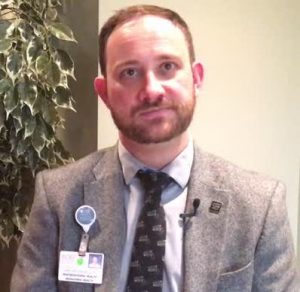OSF interactive mental health web service reaches more in need
By Holly Eaton for Chronicle Media — January 21, 2019
In 2018, OSF St. Francis Medical Center launched Silvercloud, a free behavioral health programed aimed at helping people with negative feelings that threaten to interfere with daily life. OSF also hosts a trauma support program, Strive, which is free to anyone living in the 61605 zip code. (Image courtesy of OSF St. Francis Medical Center)
Stress, anxiety, depression. For many, those feelings are seasonal. Others deal with them constantly, and, for some, negative emotions come and go without notice.
Reaching out for help can be difficult, and for those who do, it can be just as challenging to find it.
Behavioral and mental health care funding challenges began nearly two decades ago, when the State of Illinois began making deep budget cuts in that sector, cuts that continue now.
“There are barriers to understanding and barriers to access,” Luke Raymond said of the mental health care dilemma. “Depression, anxiety, stress … they certainly can have lasting effects without help.”
Raymond manages OSF St. Francis Medical Center’s behavioral health services, and was instrumental in implementing Silvercloud, an Internet service that offers free behavioral health care services.
Launched in April 2018, Raymond leveraged grant money to fund the program, which delivers clinically-proven methods, programs and support for its users.
“There is a lack of available access to these necessary services, on both ends of the spectrum,” Raymond said of behavioral and mental health care.
So, what’s the difference between the two?
“It’s a little difficult to understand the differences between those things,” he explained. “The best way to think of it is that general mental is on a spectrum, with seasonal adjustment disorder, anxiety, depression, drug and alcohol issues.“
Another way to view the difference between a behavioral problem versus a true mental impairment, is when areas of a person’s life become affected by those emotions. They begin missing work, struggling with daily activities, isolating from family and friends.
Seeking help at the onset of negative feelings can often stave off potential mental impairments, he said, which is why OSF launched Silvercloud.
This is how the website works; before signing up, visitors are asked to select a program from a menu of options. The choices are anxiety, depression, depression and anxiety and stress. After choosing one, a brief description of that program pops up.
For example, the Depression program is made up of eight modules that contain text video and audio clips and interactive activities. A member works at his or her own pace, and the program usually takes about eight weeks.
“This program will help you to learn techniques to overcome low mood and depression,” reads the summary. “Practical strategies help you to tackle unhelpful thoughts and behaviors … associated with depression.”
The anxiety portion includes avoidance reduction, mood awareness and coping skill, while the stress program addresses assertiveness, problem solving and self-esteem. All of the programs provide a “Find Help” page that provides urgent help and support for those with feelings of despair or distress.
“Finding therapy is challenging, that’s why we have our new behavioral navigation program,” Cheryl Crowe, OSF’s director of Behavioral said. “To help people who don’t know where to go or what it will cost to find help or how to understand the differences in behavioral health care.”
Because of that, she said, people often try to ignore or deny feelings associated with anxiety, depression and stress lack of motivation, irritability, isolation. Sleep disturbances and poor appetite also go hand-in-hand with behavioral troubles.
“White light therapy, whether from going outside, or from a device that produces white light, can be helpful, and engaging in self-care, spiritual, fellowship and artistic activities,” Crowe said. “But many people need more than that, counseling of some sort, to help push them through.”
Silvercloud, she said, is a highly-secured, private experience that can be accessed by computer and by handheld devices, such as smart phones. Participants, however, are not alone.
Each user is paired with a qualified supporter who works the the background to provide periodic reviews and access to additional help, when necessary.
“Supporters are trained in behavioral and mental health, some are bachelor’s qualified,” Raymond said. “They can step in when there are signs suicidality and other urgent issues.”
The site, he said, is not meant to be used for crisis intervention but when supporters see signs of crisis, the user will be directed to crisis intervention services and resources, such as the National Suicide Prevention Hotline.
OSF also offers a trauma support program which is free to those living in the 61605 zip code, the area considered as South Peoria. Called OSF Strive is geared for adults and adolescents who have been involved in a traumatic event.
Gun violence, weapon violence, domestic violence, assault and armed violence or robbery are included in such events. Such trauma is considered any experience.
Strive provides specially trained counselors and advocates who attend meetings with police, attorneys, landlords and others who the participant must deal with.
“Trauma is something we often overlook, so we developed a new trauma program STRIVE to help people deal with a traumatic experience,” Raymond said, “and we’re working to improve access to psychology and community-based support to help people lead happy and healthy lives.”
To access the Silvercloud program, visit www.osfsilvercloudhealth.com. Once registered on a web browser, a user can download the application to a smart phone for free. All who live in Woodford, Tazewell and Peoria counties should select the “Peoria” location when registering. For more information on OSF Strive, call 309-308-2030.
HOW TO USE:
To access the Silvercloud program, visit www.osfsilvercloudhealth.com. Once registered on a web browser, a user can download the application to a smart phone for free. All who live in Woodford, Tazewell and Peoria counties should select the “Peoria” location when registering. For more information on OSF Strive, call 309-308-2030.








